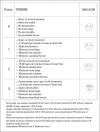Oral sucrose and a pacifier for pain relief during simple procedures in preterm infants: a randomized controlled trial
- PMID: 19448377
- PMCID: PMC2813645
- DOI: 10.4103/0256-4947.52821
Oral sucrose and a pacifier for pain relief during simple procedures in preterm infants: a randomized controlled trial
Abstract
Background and objectives: Previous randomized trials of the analgesic effects of sucrose, glucose, and a pacifier in term neonates have shown that the pacifier resulted in lower pain scores than glucose or sucrose, but the pacifier with and without sucrose did not differ. The current study was designed to assess the analgesic effect of pharmacologic (sucrose, water) and a non-pharmacologic measures (pacifier) in preterm infants and to find whether there is any synergism between these intervention in relieving pain during painful procedures.
Patients and methods: In this double-blind, randomized, controlled study, 36 preterm infants (mean 31 weeks gestational age, range 27 to 36 weeks) were randomly allocated to six different regimens (0.5 mL sterile water with pacifier, 0.5 mL sterile water without pacifier, 0.5 mL sucrose 24% with pacifier, 0.5 mL sucrose 24% without pacifier, pacifier alone and control group) during a stay in intensive care of up to 15 days. Pain scores were measured with the Premature Infant Pain Profile (PIPP), a validated behavioral acute pain scale.
Results: Of all the regimens, the lowest pain scores occurred with the use of 24% sucrose solution combined with pacifier. The mean pain score for the combination of sucrose with pacifier was 0.7 as compared to 1.4 for the sterile water with pacifier group (P<.05).
Conclusion: The synergistic effect of the combination of sucrose and non-nutritive sucking was clinically effective and safe in relieving the pain of simple procedures such as venipuncture or heel stick in preterm and term infants, but further research is needed on these interventions alone and in combination with other behavioral interventions in neonates.
Figures
References
-
- Corbo G, Mansi G, Stagni A, Romano A, van den Heuvel J, Capasso L, Raffio T, Zoccali S, Paludetto R. Non-nutritive sucking during heel stick procedures decreases behavioral distress in the newborn infant. Biol Neonate. 2000;77:162–7. - PubMed
-
- Barr R, Pantel M, Young S, Wright JH, Henddricks LA, Gravel R. The response of crying newborns to sucrose: Is it a “sweetness” effect? Physiol Behav. 1999;66:409–17. - PubMed
-
- Nikfar S, Abdollahi M, Etemad F, Sharifzadeh M. Effects of sweetening agents on morphine-induced analgesia in mice by formalin test. Gen Pharmacol. 1997;29:583–6. - PubMed
-
- Bucher H, Moster T, Siebenthal K, Keel M, Wolf M, Duc G. Sucrose reduces pain reaction to heel lancing in preterm infants: a placebo-controlled, randomized and masked study. Pediatr Res. 1995;38:332–5. - PubMed
Publication types
MeSH terms
Substances
LinkOut - more resources
Full Text Sources
Medical



